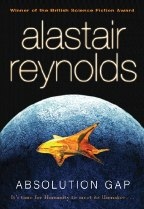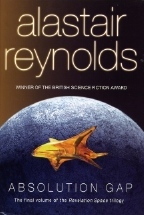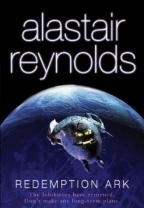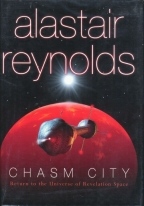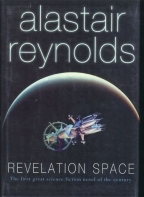From Revelation to Absolution:
Alastair Reynolds Finishes the Story
The Agony Column for May 10, 2004
Review by Rick Kleffel
Alastair Reynolds Finishes the Story
The Agony Column for May 10, 2004
Review by Rick Kleffel
Readers have good reason to be cautious when starting novels that are clearly labeled as part of a series, especially in the world of speculative fiction. Often it seems that the world of speculative fiction in particular is home to two types of series; Neverending and Grand Canyon Cliffhangers. The former type of series may start with an intriguing promise, but soon seems to lose sight of the end of the story. In fact, with each volume to come out, the resolution promised in the first volume increases in distance rather than getting closer. The thrill of the endless tease soon palls, and readers find themselves dreading new chapters as much as anticipating them. Grand Canyon Cliffhangers, on the other hand, present a brisk plot cut off at an importune point. The reader remains breathless, waiting to find out what happens next. Waiting. Caring. Waiting. Caring. Waiting. Waiting. Waiting. Reviewing serial fiction offers its own challenge. How is one to evaluate a series if one does not know the conclusion? It's like reviewing a book at the halfway point. "Good start," you might say. "Fine exposition." But all sorts of good intentions and finely executed beginnings can be annihilated by a misstep in the final pages of a novel. For this reason, many readers -- and I am occasionally one of them -- wait until a series is complete to start the first book.
Like many readers, I expected Reynolds to continue touring his universe for some time to come, keeping his characters just enough ahead of the Inhibitors to inhibit a resolution to the conflict that would drive the series. And like many readers, I would have been happy had Reynolds continued in this Neverending series mode. Reynolds offers enough fine prose, excellent characterizations, tight plots and imaginative vistas to keep even non-genre readers happy. However, in 'Absolution Gap', he eschews the easy route of the Neverending series and completes the story of the Inhibitors, the humans and the lighthugger starship Nostalgia for Infinity. It's now possible to offer an evaluation not just of this novel, but the three previous novels as well, as regards the whole series. With the story complete, it's even clearer that Reynolds is a major modern talent in genre fiction. These four novels, concluded in 'Absolution Gap', comprise a rich, entertaining, thought-provoking original vision of humanity and science unleashed like a virus across the backdrop of a carefully imagined universe.
In 2615, we find another starship, Gnostic Ascension pulling into an uncharted system. It's Quaiche's last chance to prove to the horrifying Ultra-human captain Jasmina that he has the skills to earn his keep on the ship. He sends his personal ship down to an uncharted planet, where he finds more than he could have imagined at a price that is beyond imagination as well. And in 2727, on the small frozen moon of Hela, Rashmika Els, a 16 year old archaeological prodigy, has unearthed evidence that undermines the beliefs of those who rule the vast cathedrals, huge cities in motion that circle the moon to keep the planet Haldora in view, just in case the miracle happens again. That miracle is becoming a little bit more common of late. Once again, Reynolds uses the time differential created by slower-than -light travel to help unfold a complex story that plays out over decades. The power of this novel, and its success as a cap to the series, derives both from Reynolds ability to create a detailed impression of future history and his characters. From the macrocosmic scale of his universe to the personal scale of his characters, Reynolds uses musical, detailed prose that carries the reader effortlessly into a complex, compelling story. First and foremost, the writing here is evocative and beautiful. The prose never gets in its own way, yet shines with an undercurrent of poetic precision and beauty. The density that was the hallmark of 'Revelation Space' and 'Chasm City' gets paid off in this novel. Reynolds is able to create worlds, cities, and societies that have a history the reader can feel but need to actually read about in the hundred or so books that Reynolds could clearly write about the background. Reynolds' language lets him create a world larger than we see on the pages, and in this fourth novel, the scope is served by three previous works of meticulous world-building.
But Reynolds excels as well in Rashmika Els, the argumentative teenager who seems to know what others must learn. In a sense, she's the inverse of Sky Haussman from 'Chasm City', and Reynolds plays well in unreeling her character in the style of the best mystery writers. The society that surrounds her is hidebound with fundamentalist religious traditions and the limitations of a "small town" planet. It's another excellent example of Reynolds' ability to create imaginative, cohesive societies and characters that tie directly into the societies and characters that surround us. Reynolds also provides some long-awaited character satisfaction. One of the characters he's been most careful about building has been the Captain, long ago fused into the lighthugger Nostalgia for Infinity by the Melding Plague. 'Absolution Gap' finds the Captain coming forward and making his most up-front appearances. They're perfectly, enjoyably surreal. One problem that occurs all too often in space opera series is the creation of one or more single-environment worlds. This results in simplistic, cartoonish reductions that trivialize the achievement of 'Dune' and other works. Reynolds has eschewed this easy route to create worlds that are complex and multi-faceted. Across the sweep of the four novels, readers have found worlds that reflect the variety of human life, our ability to turn even hostile environments into homes. In 'Absolution Gap', Reynolds unfolds a world of huge, mobile cities called Cathedrals. Dickensian in nature, the Cathedrals offer layer upon layer of human habitation built in the manner of a nautilus shell. It's an accretionary process. Holding the Cathedrals together is a fundamentalist religion that's painfully precise in conception. Reynolds matches the human element with the architectural structure so that each contributes to the believability of the other. We aren't world-shapers in Reynolds' future, but rather world infectors. Infection and diseases play a huge part in shaping both Reynolds' futures and his humans on both a macroscopic and microscopic scale. From the Melding Plague that fused the Captain with the lighthugger Nostalgia for Infinity to the human infections that plague otherwise uninhabitable worlds, Reynolds understands the critical role played by microbes in history, and he weaves these themes into his story as well. He's especially effective at creating landscapes that evoke the diseases within, both mental and physical. Solid, fact-based scientific speculation has been a hallmark of each of the works in Reynolds' series. They're actual, factual science fiction, spun out in with a speculative poetry that is integrated with each individual novel's plotline. 'Absolution Gap' finds Reynolds taking readers deep into string theory and arriving at the M-brane hypothesis. There's enough borrowed from cutting edge current day theory to provide the satisfying intellectual jolt that good science fiction can offer, but not so much that readers will feel as if parts of a physics textbook have been dropped in their laps.
As a novel, 'Absolution Gap' provides a very nice stand-alone jolt in the opening segments set on Hela. Reynolds creates a world with enough mystery to keep us reading breathlessly but comprehensible enough within the framework of the series to provide an enjoyable enlargement of our understanding of his vision. Reynolds has shown again and again in this series his understanding of the importance of the mystery quotient in science fiction writing. He's an expert at tipping the reader back and forth between a state of wondering and a state of wonder. The characters created especially for the novel are compelling and well-wrought enough to hold their own against characters we've known over the previous three novels.
As the end of a series, 'Absolution Gap' provides a sense of completion but not overfill. Even as the series ends, Reynolds can't stop himself leaving the reader wanting -- but not needing -- more. Readers now have the full story to evaluate, from beginning to end. Reynolds' series has a frosty start, to be sure. The character who dominates the beginning of the novel and the series, Dan Sylveste, is daringly and bracingly unlikable. Coupled with Reynolds' unusual stipulation of no faster-than-light travel, Reynolds' universe is hardly inviting. This not the utopian future of 'Star Trek', nor is it the simplistic fantasy playground of 'Star Wars'. Instead, it's more like the derelict ship found at the beginning of the movie 'Alien'; dense, filled with a history that the audience can sense without having to experience in detail. As Reynolds introduces the lighthugger Nostalgia for Infinity and her crew, as the careful construction of his multi-layered plot unfolds, readers can enjoy his ability to always provide just the right level of detail, just the right level of poetry in his prose. 'Chasm City' is a wonderfully detailed detour, a melting pot in which Reynolds cooks up powerful characters in a richly imagined setting and a carefully layered mystery. 'Redemption Ark' and 'Absolution Gap' round out the series nicely, offering battle and resolution, a forward thrust and a thrilling finish. If you start out reading 'Revelation Space', you're in for a treat. There are four novels in all that await you, which will evoke a variety of moods and create worlds you'll fear and enjoy. Alastair Reynolds has presented the new century with a remarkable prose creation. The beginning and the end of the universe await you. |
